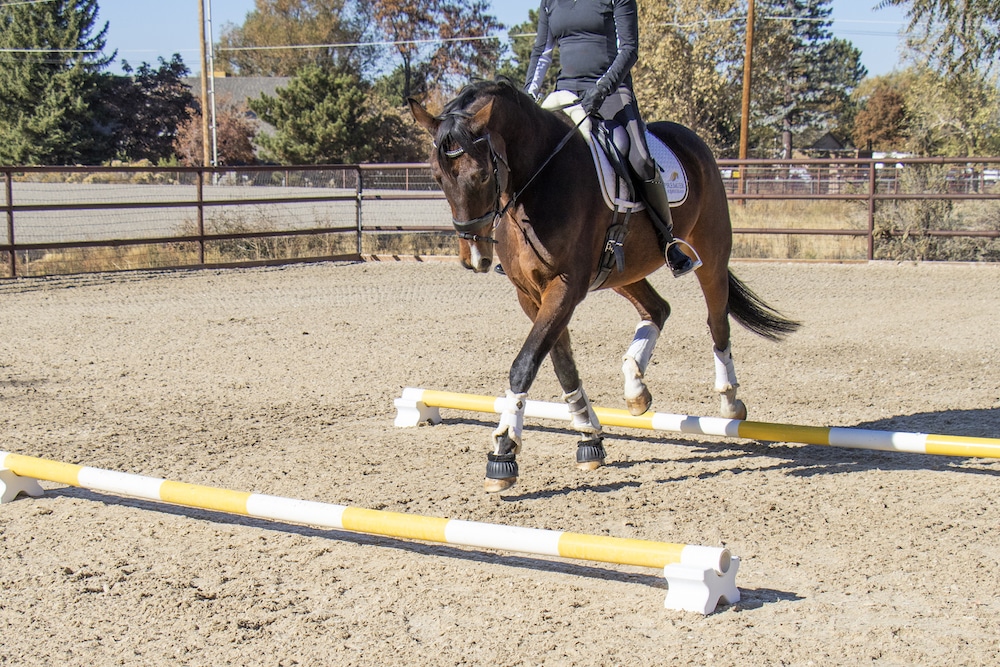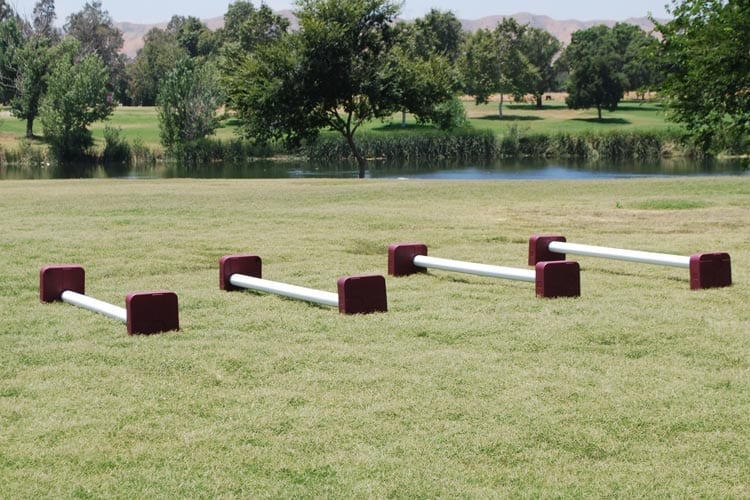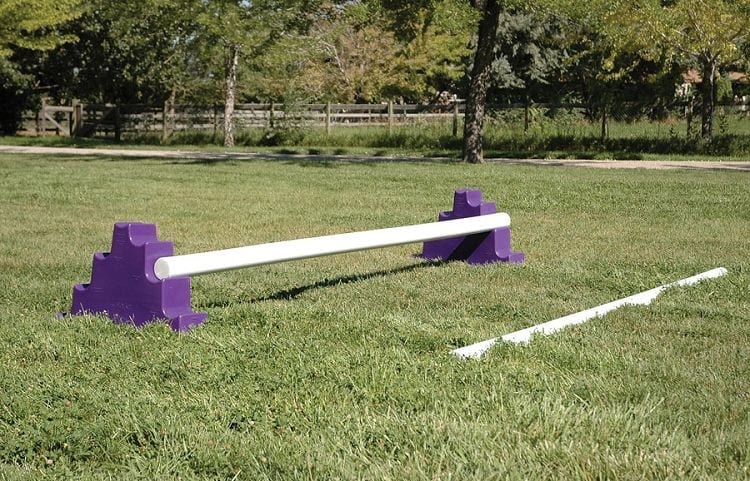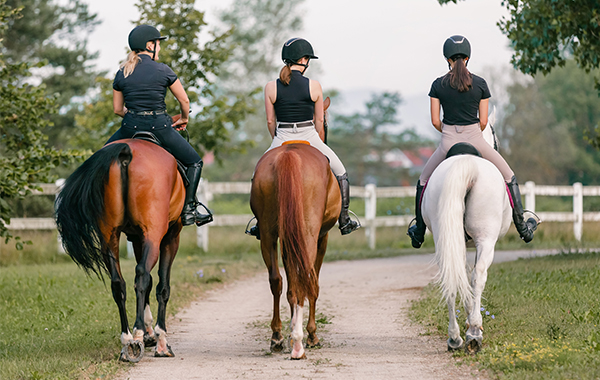It may sound like fancy pasta, but cavaletti is in fact a must-have item for your riding arena.
Whether you are a jumping rider or a student of dressage, top trainers all agree: the regular use of cavaletti exercises will help improve the fundamental skills and qualities of movement essential for success in most equestrian disciplines. Cavaletti work benefits horses and riders at all levels and stages of experience. If you are not familiar with cavaletti, or are simply unsure where to get started, this blog post is for you! In this introductory guide, we offer the who, what, where, when, and why of cavaletti work, along with some suggested additional resources.

Premier Equestrian President Heidi Zorn and her horse, Primo, trotting over our Cavaletti Riser Blocks
What Are Cavaletti?
Simply put, cavaletti is a type of raised rail or small jump used singly or in combination to help train horses. The word “cavaletti” comes from the Italian word for horse (cavallo) and translates to “little horse.” But cavaletti can be used to improve horses of all sizes, breeds, and backgrounds.
Traditionally made from a wooden rail secured to a block or “X” at either end, cavaletti are rotated to differing heights to increase or decrease the difficulty of an exercise. Today, cavaletti can be made not just of wood, but also molded plastic or filled PVC rails. Common jump rails can also do double duty both on course and in cavaletti exercises by adding removeable blocks to either end.
Check out Premier Equestrian’s Quick Cavaletti Pairs (colorful blocks that work with both round or square poles) or Cavaletti Riser Blocks (made with HDPE and designed to resist the wear and tear common with wood) to convert your existing jump rails into versatile cavaletti.

Sold in pairs, this Quick Cavaletti offers easy set up with a variety of heights
Cavaletti Do’s & Don’ts
When selecting your materials, here are a few pro tips:
DO choose rails that are close to 8–10’in length. Skinnier rails can have their place in accuracy exercises but are overall less versatile, while longer rails can be unwieldy, particularly if you share your arena with others.
DO choose rails of solid construction and design. Lightweight materials are not appropriate for cavaletti, as some horses quickly determine that they can simply push through or step on the equipment. At best, this destroys your equipment and defeats the purpose of the exercise; at worst, a shattered rail could scare or injure your horse.
DON’T use a round rail for cavaletti work without blocks to support the ends. Round rails roll, and if your horse steps directly onto one, it acts like a roller skate. If a horse steps onto a blocked rail, they may stumble but are much less likely to slip and slide (risking soft tissue injury).

You can set a low grid or bounce workout with the Quick Cavaletti
Why Should I Use Cavaletti?
There are SO many reasons: Working through progressive exercises over cavaletti rails improves the rhythm, balance, suppleness, cadence, and self-carriage of the horse; it challenges the horse’s proprioceptive sense and helps them become nimbler and more sure-footed. For the rider, cavaletti work can improve her sense of timing, rhythm, and balance, and develops strength and coordination. Plus, it is simply a ton of fun!
Just like many of us enjoy a daily Sudoku or Wordle puzzle, cavaletti exercises give horses a problem to solve. Most of them seem to move with a sense of pride when they execute the work correctly. And if your horse is one that can become bored or distracted in the arena, cavaletti is an excellent tool to help them refocus.
Does your horse have weakness in the stifle joint, or the hamstrings, glutes, or longissimus muscles? Even basic work over cavaletti causes the horse to flex and engage the muscles, ligaments, and tendons in the hindquarters, as well as improves lift and reach in the shoulders and forelimbs. Just like pumping iron at the gym for human athletes, cavaletti work can help to quickly lay down muscles in our horses. While not a perfect substitute for a good hill climb, routine use of cavaletti exercises can bridge the gap for riders stuck indoors for extended periods or those without access to more rigorous terrain for conditioning.
Cavaletti can be custom set to your horse’s individual stride length and manner of travel, which helps to build their confidence and develops relaxation. Over time, micro adjustments to the distances between cavalettis can train horses to move with longer or shorter strides—all while maintaining essential qualities of movement such as rhythm, suppleness, connection, impulsion, and straightness.
Riders looking to gain strength in their own legs, back, and core will find that executing posting trot or two-point position over cavalettis adds more “bang for your buck” to every minute spent in the saddle.
One important note is that when it comes to cavaletti work, “little and often” is an important mantra. Because work over rails challenges the horse’s mind and body in new ways, it can be extremely fatiguing. To keep your horse’s attitude fresh and to avoid sore muscles, use your cavaletti exercises strategically during a work set—for example, after the warmup phase but before the main schooling session begins. Ride through your pre-set exercise anywhere from 6 to 10 times total, and work exercises equally off either rein.
Who Should Use Cavaletti?
Every horse and rider will benefit from routine cavaletti work. Regardless of your preferred discipline, all riders appreciate a soft, well-balanced horse with an adjustable stride. Cavaletti exercises can help develop these qualities in the horse, while the rider learns to support and follow the horse with her natural aids.
The key is to take each exercise in bite-sized stages. Start with the cavaletti on their lowest setting and use a tape measure to set exercises with precision. Only add complexity or greater height as both horse and rider become confident and successful with simpler exercises. Some exercises suit the walk, others the trot or canter. Start with the basics and work your way up from there.

This multilevel Stacker Cavaletti allows you to build a jump in a variety of heights in 3-inch increments
How Do I Get Started With Cavaletti?
The first step is, of course, obtaining a set of cavaletti to use. You can build your own, or purchase blocks and rails. A set of three is a great place to start but having more cavaletti at your disposal will allow for a range of new exercises.
For versatility, check out The Stacker Cavaletti. These colorful, UV-resistant plastic cavaletti blocks allow riders to set their rails anywhere from 6”-24” in 3” increments and can be set for either direction. Premier Equestrian also offers a range of high quality, long-lasting poles in an array of colors and price points that are compatible with all blocks and stackers.
Where Can I Learn More About Cavaletti?
There are about as many different cavaletti exercises as there are stars in the sky; fortunately, several top equestrians have published excellent, well-diagrammed books to help you select exercises that will benefit you and your mount. One of my personal favorites is Cavaletti for Dressage and Jumping by Ingrid and Reiner Klimke (2014, J.A. Allen). The late Reiner Klimke was an Olympic gold medalist in dressage, and his daughter Ingrid has ridden on German championship teams in both eventing and dressage; she utilizes cavaletti work with all of her horses at all stages of training. When it comes to Ingrid, I’m definitely a fangirl, and my copy of this book is highlighted and dog-eared.
YouTube is also home to many quality videos of cavaletti set ups, exercises and patterns, along with tips for success and techniques to avoid common problems. In fact, Premier Equestrian produced an outstanding series of videos with dressage master Walter Zettl, including this one in which he discusses the critical importance of cavaletti in a dressage horse’s work:
About the author
Christina Keim is a professional equestrian and writer based at Cold Moon Farm in Rochester, NH. Over the course of her career, she has worked as a barn manager, head groom, riding instructor, and collegiate equestrian team coach. In 2015, she founded Cold Moon Farm with the mission to promote sustainable living, conservation, and the highest standards of compassionate horsemanship.





